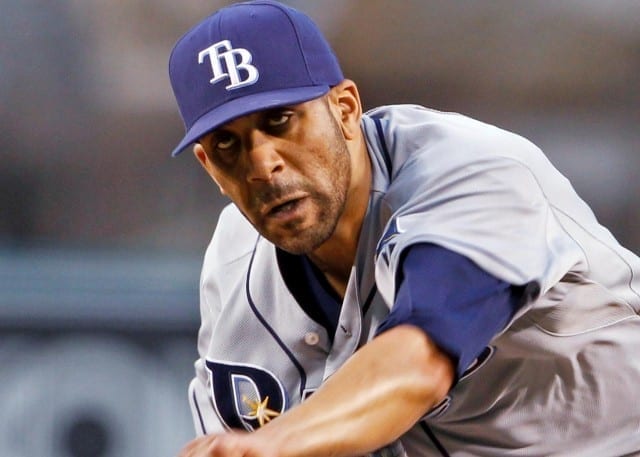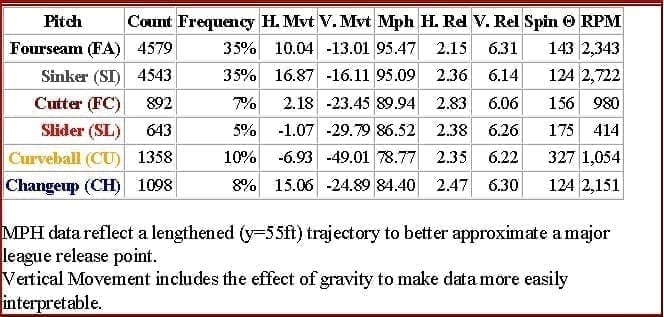The Baltimore Orioles and Tampa Bay Rays kick off their 2013 season against one another today and what better way to get things rolling then scout the opposing pitcher, David Price.
David Price has been quite the challenge for the Orioles over his career as he is 6-2 with a 2.21 ERA over 21 starts and 81.1 innings against them. Last year alone he was 2-0 with a 0.40 ERA over three starts and 22.1 innings. Needless to say, I don’t think Price will be slowing down any time soon but you never know.
Is there a way to get the better of Price today though?
In order to answer that question I decided to pull his PITCHf/x profile from Baseball Prospectus and figure out exactly what the Orioles could expect from him. The data in the chart below is for all seasons that he has been in the league and there are several zone charts displaying his various pitches based on whether they are considered hard, offspeed, or breaking pitches.
This chart shows the frequency with which Price throws certain pitches on 0-0 counts, which he will encounter with every new batter (obviously) and you can see that he typically starts hitters off with his sinker or his fastball. Because Price has a tendency to hang around the middle of the plate with his fastball it may not be such a bad strategy to take a few aggressive cuts against that first pitch with the hope to square one up. He’s not one to tire all that much after 90 or so pitches so pitch count won’t really factor in today’s game much.
The Orioles may find themselves in some 0-2 counts against Price, as many batters do, and in this particular situation he’s going to try to blow his fastball by you. Followed by his other hard stuff (sinker and cutter) which leads me to believe he falls into the frame of mind of blowing the batter away. This is something that the Orioles could use to their advantage if he does follow this same pattern today. Take aggressive cuts because he’s going to keep it around the strike zone.
However, knowing or having a very good idea of what Price is going to throw is only half the battle because you also need to have an idea of where he’s going to try to locate that pitch. The first zone chart that I showed you had all of his pitches included and the frequency in which he throws them at certain spots in, or out of, the strike zone. Now it’s time to break it down even further by looking at where he generally locates his hard stuff (fastball, sinker, cutter), where he generally locates his offspeed pitch (changeup), and then of course where he predominantly locates his breaking pitches (slider, curveball).
From this zone chart, which shows us his hard stuff, you can see that he likes to blow it by the hitters around the middle of the strike zone. However, he also likes to get inside to hitters as well and it’s difficult to get around on any of these pitches because his fastball and sinker are coming in around 96 mph with regularity and his cutter sits in the low 90’s. It’s obvious why hitters have such a difficult time with Price because he throws with such force and he’s left-handed.
Taking a look at his zone chart for his changeup there’s one thing that really sticks out to me which is he rarely throws it to left-handed hitters. As a matter of fact, he has only thrown a changeup to left-handed hitters eight times during his time in the big leagues. Whether that’s because he doesn’t want to take the chance of hanging one to someone who could pull it, whether it’s because he doesn’t face too many left-handed batters, or a combination of the two I have no idea.
When facing right-handed hitters though he likes to keep it in the low, outside corner — he doesn’t appear to come inside to right-handed batters too often and it’s likely because he doesn’t want to take the chance they could do any real damage to it.
Now we come to the final zone chart we are going to look at and this one looks at his slider and that dangerous curveball he has. Price seems to have one dominant strategy with both of these pitches and that is to either keep it on the low-outside corner to left-handed hitters or the low-inside corner to right-handed hitters. He seems to continuously hit the same spots with these two pitches.
Even though we know what David Price throws and the areas of the strike zone he likes to frequent, his stuff is so overpowering sometimes that it doesn’t always make a difference. When he’s able to come at you with a 96 mph fastball, or sinker for that matter, and then freeze you in your place with a 78 mph curveball it presents a major challenge.




